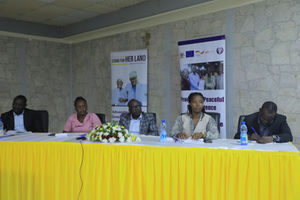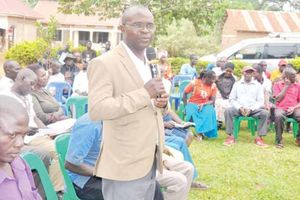
Experts speak during the dialogue yesterday. PHOTO/BUSEIN SAMILU
The period for processing land titles is to drop from between 21 days and four months to just 10 days.
This follows a decision by the Ministry of Lands, Housing and Urban Development to cut back the steps of processing land titles from 27 to only four.
Mr Dennis Obbo, the spokesperson of the Lands ministry, told this newspaper last night that the four new steps will embrace data collection and surveying, District Land Board and Physical Planning sitting minutes for approvals, data processing, and issuance of certificates of title/ ownership.
He said the revised steps would reduce both the time spent and the cost of processing a title.
The previous steps included 27 processes.
Mr Obbo said: “When you look at the previous steps, they are time-wasting and what we are trying to do is that the person gets multiple services in the shortest time possible. For instance, at the district, they don’t have to rotate for days to see the District Land Board, district land officer, and the surveyor, but are served in one day and the same should be at the Ministry Zonal Offices,” he said.
The steps, which are currently being piloted in Karamoja Sub-region, were developed after a benchmarking study visit to the Georgian land registration model in eastern Europe.
Technocrats at the ministry are expected to meet today over the reforms, consider reviewing the Land Act, 1998, and the 2013 Land Policy to give them legal backing before embarking on the exercise.
Mr Obbo said anyone applying for a title in the current four-tenure land systems, including; Mailo, Freehold, Leasehold, and Customary, will go through the same new four-step process.
Mailo Tenure, which is predominant in Buganda, is where the land has two owners, including the landlord who holds final rights on the land and a Bonafide occupant (Kibanja holder) who stays on the land but pays the landlord annual rent called Busuulu.
Freehold tenure refers to land held/owned by an individual registered on the certificate of title as the landowner for life.
Leasehold tenure system is where a land owner allows another person to take exclusive possession for a specific period of three years or more in exchange for rent, while the customary tenure system refers to land that is owned based on the norms and traditions of a given community or society in Uganda and this is mainly in Northern and Eastern regions.
Ms Dorcas Okalanyi, the ministry permanent secretary, through Mr Obbo, said the move is aimed at systematically reducing both the time and money spent during land registration.
“This will reduce the corruption tendencies because it will reduce the face-to-face interactions between the clients and land officers,” she said.
Experts and land lawyers hailed the move as one that will improve land registration and at the same time reduce corruption tendencies.
Mr Elias Nalukoola, a land lawyer, said: “The current lengthy procedure is a basis for demanding and receiving bribes by officials in the ministry because someone may be told that it will take months to go through the correct procedures and they decide to bribe and get their titles in time.”
Ms Frances Birungi, the executive director of the Uganda Community-Based Association for Women and Children Welfare (UCOBAC), said land registration should be deliberately made affordable to all to strengthen people’s stay and investments on the land.
“As a country, we have the National Development Plan which is aimed at driving the country’s development. So infrastructure development and investment are critical but at the same time we know that the citizens rely on land and in that sense, we need to support the development of the country but at the same time should be able to enjoy their land rights,” she said.
“A lot of innovations are happening regarding registration of land rights to ensure people have security for tenure to live on their land without fear. We found out that the ongoing land registration processes are largely facilitated by development partners and donors like GIZ, the World Bank, and UN Habitant yet this funding is not sustainable since they are time-bound, making the processes half-baked yet all people should benefit and that’s why we need to ensure that these processes are sustained beyond the donor support,” she added.
Mr Alozius Gonza, the president of Institution of Surveyors, welcomed the move, which he said would reduce the cost of surveying land that has been met by the clients.
“Our plea is that the government implements the National Land Information System as they review these steps so that surveyors can just submit the work and receive feedback digitally instead of a surveyor having to travel up to a Ministry Zonal Office for a review, which costs are still met by the clients,” he said.
However, Dr Theresa Auma, the executive director of the Land and Equity Movement in Uganda (LEMU), said the reduction might not do much because of lack of public trust, where locals see the State’s registration of their land as an avenue of grabbing it.
“If we go back to history, the Uganda State since 1900 has been promoting land registration, but after more than 100 years we still have more than 70 percent of the land unregistered. The slow speed of land registration has actually not only been about the high cost or even the lengthy steps involved, as it is always explained,” she said.
Dr Auma said: “This perception informed community hostilities towards government surveyors as was seen in some locations like Kamuda in Soroti District in the mid-2000s. The second area of contention, which is still not resolved, is that land registration facilitates individualisation of land, yet most communities that hold customary land do not hold it as individuals but rather as families, clans and communities. Under such circumstances, the question of whose name will be on the land title breeds questions, conflicts and has the potential to halt the process. Thirdly, there are still contestations around the registration of women’s land rights in communities where men believe women should not own land.”
Land registration steps
New steps being developed, pretested and piloted.
1. Data collection and surveying;
2. District Land Board and Physical planning sitting minutes for approvals;
3. Data processing
4. Issuance of certificates of title /certificates of ownership.
Source: Dennis Obbo, Spokesperson
Ministry of Lands, Housing & Urban Development
The old steps
1. Pick application form from subcounty or ministry of lands website;
2. Pay Application fees;
3. Submit Application forms to Area land Committee;
4. Area land Committee issues a Public Notice;
5. After 14 days, the Area Land Committee hold a meeting to inspect the land;
6. Area Land Committee writes a detailed inspection report;
7. Area land Committee submits the application to sub county Physical Planning Committee to check compliance with Physical plan and returns forms to Area Land Committee for submission to District Land Office;
8. District land Office and District Physical Planning committee check compliance and issue approval;
9. District Land Board convenes a meeting and issues a minute for survey by a private registered surveyor at the cost of the applicant
10. Decisions of the District Land Board are sent to the District Land Office to communicate to applicants and pay the required fees;
11. Applicant submits general receipts of payment;
12. District Land Officer confirms payments and Application is submitted to the Ministry Zonal Office;
13. Prints are uploaded on the Surveyors Portal for further processing by the MZO;
14. File Application goes back to DLB to resolve a minute offering the conversion;
15. Application is re submitted to MZO for issuance of Title;
16. At the MZO, an acknowledgement is issued to applicant;
17. Intake of documents is done;
18. Scanning of documents is done;
19. Review compliance by MZO physical planner (2 times);
20. Review compliance by MZO land officer (2 times);
21. Review compliance by surveyor
22. Review compliance by registrar of titles;
23. Printing and signing of title
24. Scan outgoing documents
25. Delivery and Acknowledgement of title.
What they say...
Mr Dennis Obbo, spokesperson of the Lands ministry.
‘When you look at these steps, they are time wasting and what we are trying to do is that the person gets multiple services in the shortest time possible in the area. If it is at the district, they don’t have to rotate for days to see the DLB, district land officer, surveyor but be worked on in one day.’’
Ms Frances Birungi, ED Uganda Community Based Association for Women and Children welfare.
‘‘A lot of innovations are happening in regard to registration of land rights basically to ensure that people have security for tenure so that they live on their land without fear. We found out that the ongoing land registration processes are largely facilitated by development partners and donors yet this funding is not sustainable.’’
Dr Theresa Auma, ED Land and Equity Movement in Uganda.
‘‘If we go back to history, the Uganda State since 1900 has been promoting land registration, but after more than 100 years, we still have more than 70 percent of the land unregistered. The slow speed of land registration has actually not only been about the high cost or even the lengthy steps involved, as it is always explained.’’
Mr Elias Nalukoola, a land lawyer.
‘…The current lengthy procedure is a basis for demanding and receiving bribes by officials in the ministry because someone may be told that it will take months to go through the correct procedures and they decide to bribe and get their titles in time.”
Alozius Gonza, president of Institution of Surveyors.
‘Our plea is that the government implements the National Land Information System as they review these steps so that surveyors can just submit the work digitally, receive feedback digitally instead of, for example, a surveyor having to travel up to Mubende for review which costs are still met by the clients.




